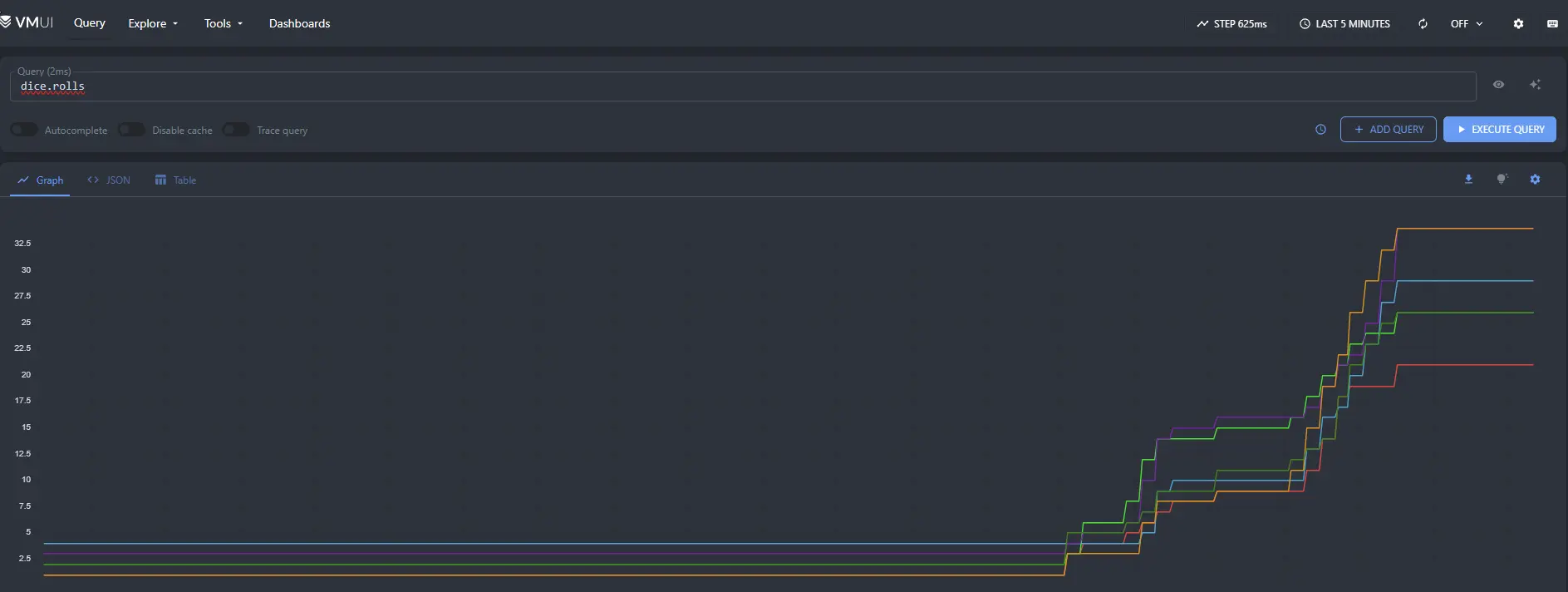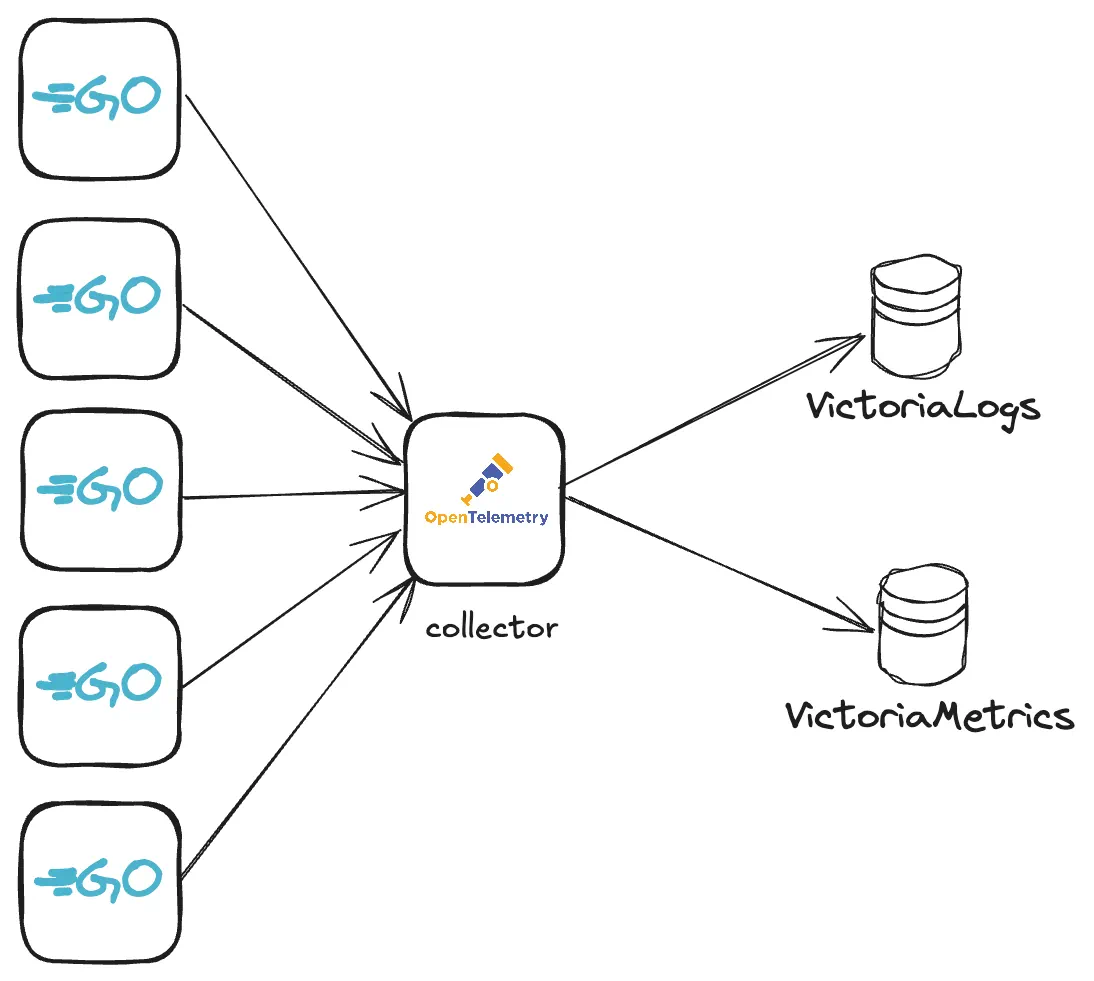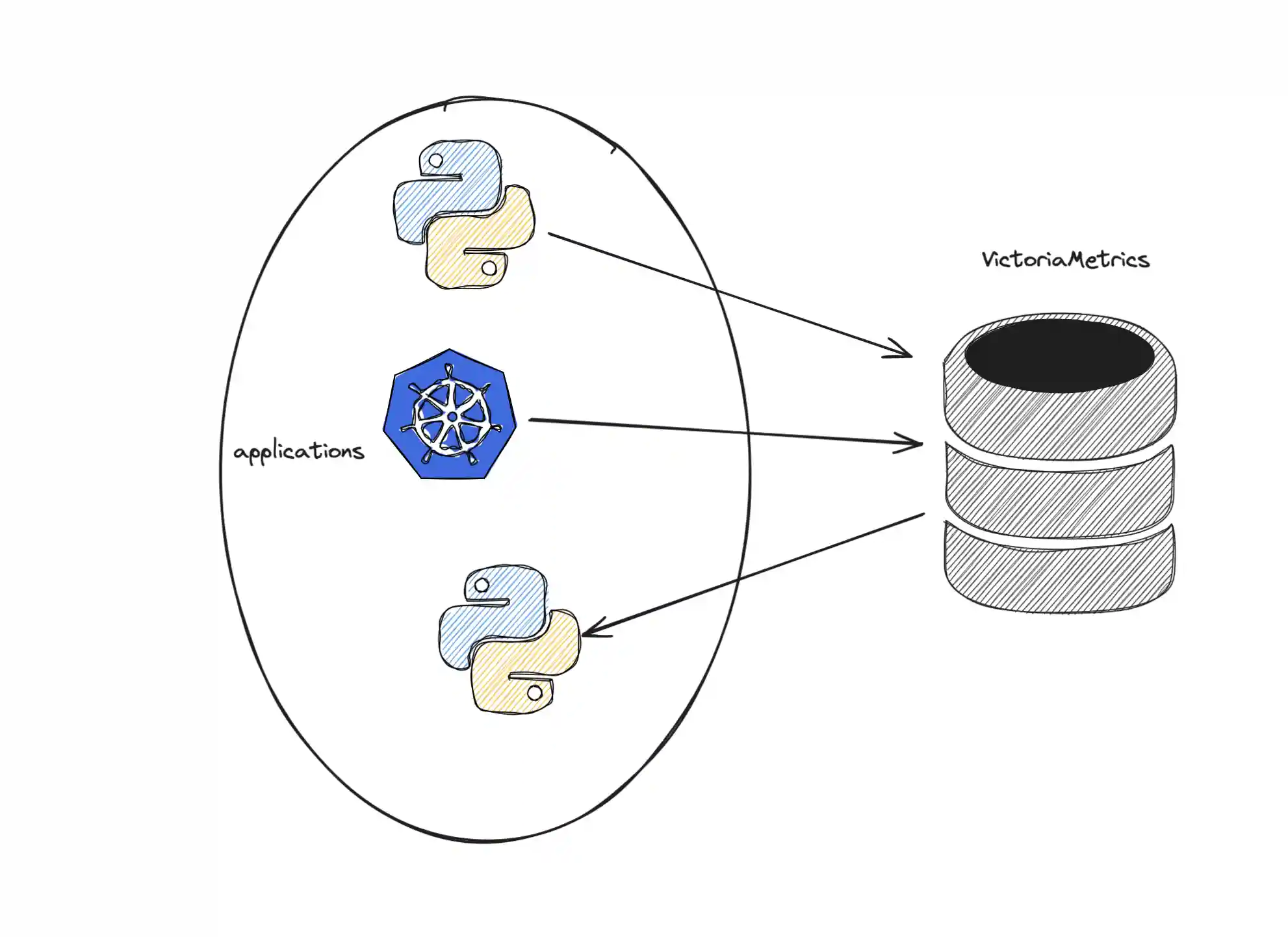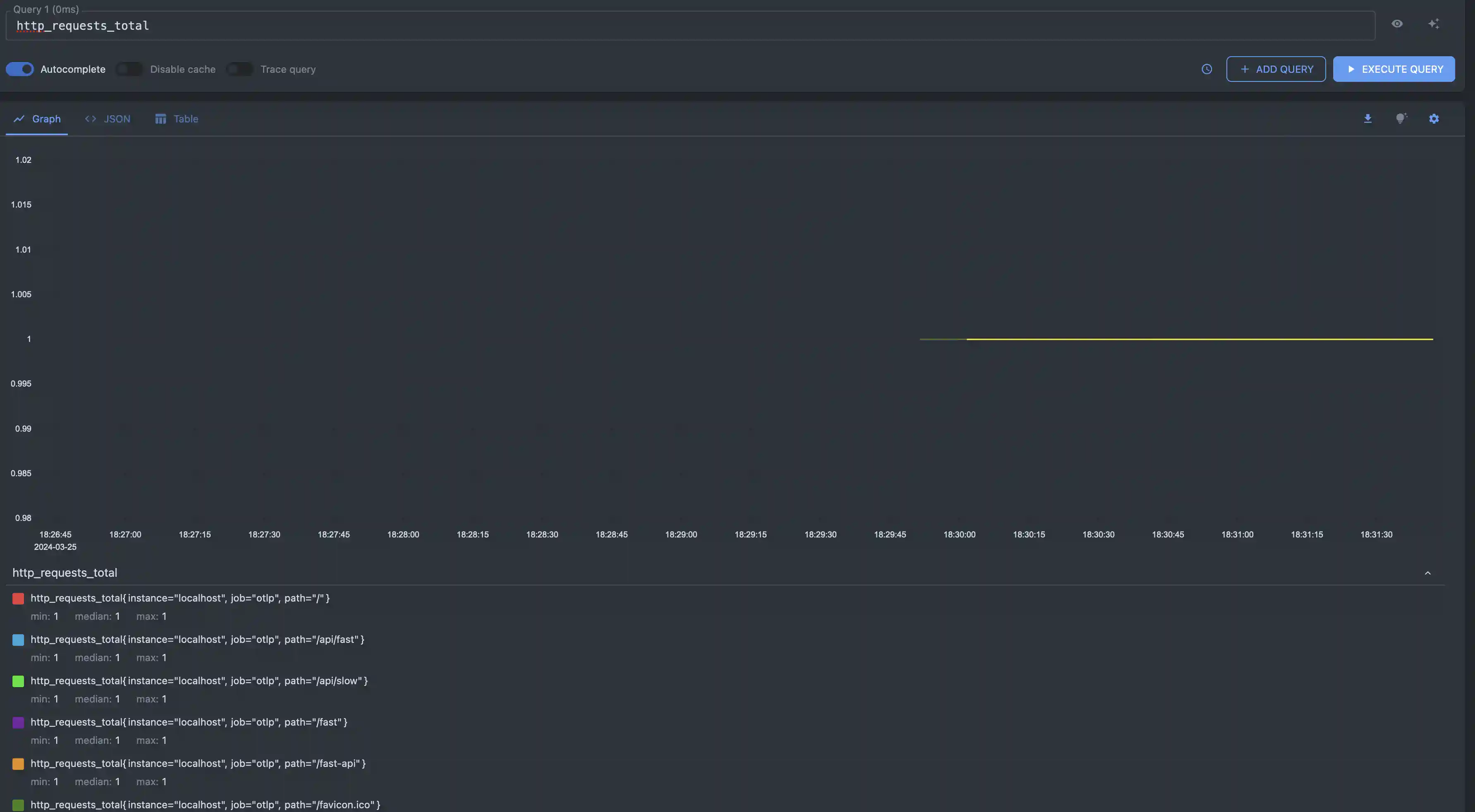### Describe Your Changes
This pull request fixes incorrect URLs in two places:
1. In the OTel guide, which has been corrected in
https://github.com/VictoriaMetrics/VictoriaMetrics/pull/6880, but one
incorrect URL is still missing.
2. In the URL example, the cache reset endpoint for vmselect / Cluster
version is `/internal/resetRollupResultCache`, but it is mistakenly
noted as `/select/internal/resetRollupResultCache`, which misguides the
user. (introduced in #4468)
### Checklist
The following checks are **mandatory**:
- [x] My change adheres [VictoriaMetrics contributing
guidelines](https://docs.victoriametrics.com/contributing/).
(cherry picked from commit
|
||
|---|---|---|
| .. | ||
| _index.md | ||
| app.go-collector.example | ||
| app.go.example | ||
| collector.webp | ||
| direct.webp | ||
| README.md | ||
| vmui-dice-roll.webp | ||
| vmui.webp | ||
VictoriaMetrics supports metrics ingestion with OpenTelemetry metrics format. This guide covers data ingestion via opentelemetry-collector and direct metrics push from application.
Pre-Requirements
Install VictoriaMetrics single-server via helm chart
Install single-server version:
helm repo add vm https://victoriametrics.github.io/helm-charts/
helm repo update
helm install victoria-metrics vm/victoria-metrics-single
Verify it's up and running:
kubectl get pods
# victoria-metrics-victoria-metrics-single-server-0 1/1 Running 0 3m1s
Helm chart provides the following urls for reading and writing data:
Write url inside the kubernetes cluster:
http://victoria-metrics-victoria-metrics-single-server.default.svc.cluster.local:8428
Read Data:
The following url can be used as the datasource url in Grafana:
http://victoria-metrics-victoria-metrics-single-server.default.svc.cluster.local:8428
Using opentelemetry-collector with VictoriaMetrics
Deploy opentelemetry-collector and configure metrics forwarding
helm repo add open-telemetry https://open-telemetry.github.io/opentelemetry-helm-charts
helm repo update
# add values
cat << EOF > values.yaml
mode: deployment
image:
repository: "otel/opentelemetry-collector-contrib"
presets:
clusterMetrics:
enabled: true
config:
receivers:
otlp:
protocols:
grpc:
endpoint: 0.0.0.0:4317
http:
endpoint: 0.0.0.0:4318
exporters:
otlphttp/victoriametrics:
compression: gzip
encoding: proto
endpoint: http://victoria-metrics-victoria-metrics-single-server.default.svc.cluster.local:8428/opentelemetry
tls:
insecure: true
service:
pipelines:
metrics:
receivers: [otlp]
processors: []
exporters: [otlphttp/victoriametrics]
EOF
# install helm chart
helm upgrade -i otl-collector open-telemetry/opentelemetry-collector -f values.yaml
# check if pod is healthy
kubectl get pod
NAME READY STATUS RESTARTS AGE
otl-collector-opentelemetry-collector-7467bbb559-2pq2n 1/1 Running 0 23m
# forward port to local machine to verify metrics are ingested
kubectl port-forward service/victoria-metrics-victoria-metrics-single-server 8428
# check metric `k8s_container_ready` via browser http://localhost:8428/vmui/#/?g0.expr=k8s_container_ready
# forward port to local machine to setup opentelemetry-collector locally
kubectl port-forward otl-collector-opentelemetry-collector 4318
The full version of possible configuration options could be found in OpenTelemetry docs.
Sending to VictoriaMetrics via OpenTelemetry
Metrics could be sent to VictoriaMetrics via OpenTelemetry instrumentation libraries. You can use any compatible OpenTelemetry instrumentation clients. In our example, we'll create a WEB server in Golang and instrument it with metrics.
Building the Go application instrumented with metrics
Copy the go file from here. This will give you a basic implementation of a dice roll WEB server with the urls for opentelemetry-collector pointing to localhost:4318.
In the same directory run the following command to create the go.mod file:
go mod init vm/otel
For demo purposes, we'll add the following dependencies to go.mod file:
require (
go.opentelemetry.io/contrib/instrumentation/net/http/otelhttp v0.52.0
go.opentelemetry.io/otel v1.27.0
go.opentelemetry.io/otel/exporters/otlp/otlpmetric/otlpmetrichttp v1.27.0
go.opentelemetry.io/otel/exporters/otlp/otlptrace/otlptracehttp v1.27.0
go.opentelemetry.io/otel/metric v1.27.0
go.opentelemetry.io/otel/sdk v1.27.0
go.opentelemetry.io/otel/sdk/metric v1.27.0
)
require (
github.com/cenkalti/backoff/v4 v4.3.0 // indirect
github.com/felixge/httpsnoop v1.0.4 // indirect
github.com/go-logr/logr v1.4.1 // indirectdice.rolls
github.com/go-logr/stdr v1.2.2 // indirect
github.com/grpc-ecosystem/grpc-gateway/v2 v2.20.0 // indirect
go.opentelemetry.io/otel/exporters/otlp/otlptrace v1.27.0 // indirect
go.opentelemetry.io/otel/trace v1.27.0 // indirect
go.opentelemetry.io/proto/otlp v1.2.0 // indirect
golang.org/x/net v0.25.0 // indirect
golang.org/x/sys v0.20.0 // indirect
golang.org/x/text v0.15.0 // indirect
google.golang.org/genproto/googleapis/api v0.0.0-20240520151616-dc85e6b867a5 // indirect
google.golang.org/genproto/googleapis/rpc v0.0.0-20240515191416-fc5f0ca64291 // indirect
google.golang.org/grpc v1.64.0 // indirect
google.golang.org/protobuf v1.34.1 // indirect
)
Once you have these in your go.mod file, you can run the following command to download the dependencies:
go mod tidy
Now you can run the application:
go run .
Test metrics ingestion
By default, the application will be available at localhost:8080. You can start sending requests to /rolldice endpoint to generate metrics. The following command will send 20 requests to the /rolldice endpoint:
for i in `seq 1 20`; do curl http://localhost:8080/rolldice; done
After a few seconds you should start to see metrics sent over to the vmui interface by visiting http://localhost:8428/vmui/#/?g0.expr=dice.rolls in your browser or by querying the metric dice.rolls in the vmui interface.

Direct metrics push
Metrics could be ingested into VictoriaMetrics directly with HTTP requests. You can use any compatible OpenTelemetry instrumentation clients. In our example, we'll create a WEB server in Golang and instrument it with metrics.
Building the Go application instrumented with metrics
See the full source code of the example here.
The list of OpenTelemetry dependencies for go.mod is the following:
go 1.20
require (
go.opentelemetry.io/otel v1.7.0
go.opentelemetry.io/otel/exporters/otlp/otlpmetric v0.30.0
go.opentelemetry.io/otel/exporters/otlp/otlpmetric/otlpmetrichttp v0.30.0
go.opentelemetry.io/otel/metric v0.30.0
go.opentelemetry.io/otel/sdk v1.7.0
go.opentelemetry.io/otel/sdk/metric v0.30.0
)
Let's create a new file main.go with basic implementation of the WEB server:
package main
func main() {
mux := http.NewServeMux()
mux.HandleFunc("/api/fast", func(writer http.ResponseWriter, request *http.Request) {
writer.WriteHeader(http.StatusOK)
writer.Write([]byte(`fast ok`))
})
mux.HandleFunc("/api/slow", func(writer http.ResponseWriter, request *http.Request) {
time.Sleep(time.Second * 2)
writer.WriteHeader(http.StatusOK)
writer.Write([]byte(`slow ok`))
})
mw, err := newMetricsMiddleware(mux)
if err != nil {
panic(fmt.Sprintf("cannot build metricMiddleWare: %q", err))
}
go func() {
http.ListenAndServe("localhost:8081", mw)
}()
}
In the code above, we used newMetricsMiddleware function to create a handler for our server.
Let's define it below:
type metricMiddleWare struct {
h http.Handler
requestsCount syncint64.Counter
requestsLatency syncfloat64.Histogram
activeRequests int64
}
func newMetricsMiddleware(h http.Handler) (*metricMiddleWare, error) {
mw := &metricMiddleWare{h: h}
mc, err := newMetricsController(ctx)
if err != nil {
return nil, fmt.Errorf("cannot build metrics collector: %w", err)
}
global.SetMeterProvider(mc)
prov := mc.Meter("")
mw.requestsLatency, err = prov.SyncFloat64().Histogram("http_request_latency_seconds")
if err != nil {
return nil, fmt.Errorf("cannot create histogram: %w", err)
}
mw.requestsCount, err = prov.SyncInt64().Counter("http_requests_total")
if err != nil {
return nil, fmt.Errorf("cannot create syncInt64 counter: %w", err)
}
ar, err := prov.AsyncInt64().Gauge("http_active_requests")
if err != nil {
return nil, fmt.Errorf("cannot create AsyncInt64 gauge: %w", err)
}
if err := prov.RegisterCallback([]instrument.Asynchronous{ar}, func(ctx context.Context) {
ar.Observe(ctx, atomic.LoadInt64(&mw.activeRequests))
}); err != nil {
return nil, fmt.Errorf("cannot Register int64 gauge: %w", err)
}
return mw, nil
}
The new type metricMiddleWare is instrumented with 3 metrics
initialized in newMetricsMiddleware method:
- counter
http_requests_total - histogram
http_request_latency_seconds - gauge
http_active_requests
Let's implement http.Handler interface for metricMiddleWare by adding ServeHTTP method:
func (m *metricMiddleWare) ServeHTTP(w http.ResponseWriter, r *http.Request) {
t := time.Now()
path := r.URL.Path
m.requestsCount.Add(nil, 1, attribute.String("path", path))
atomic.AddInt64(&m.activeRequests, 1)
defer func() {
atomic.AddInt64(&m.activeRequests, -1)
m.requestsLatency.Record(nil, time.Since(t).Seconds(), attribute.String("path", path))
}()
m.h.ServeHTTP(w, r)
}
In method above, our middleware processes received HTTP requests and updates metrics with each new request.
But for these metrics to be shipped we need to add a new method newMetricsController to organize metrics collection:
func newMetricsController(ctx context.Context) (*controller.Controller, error) {
options := []otlpmetrichttp.Option{
otlpmetrichttp.WithEndpoint("<VictoriaMetrics endpoint - host:port>"),
otlpmetrichttp.WithURLPath("/opentelemetry/api/v1/push"),
}
metricExporter, err := otlpmetrichttp.New(ctx, options...)
if err != nil {
return nil, fmt.Errorf("cannot create otlphttp exporter: %w", err)
}
resourceConfig, err := resource.New(ctx, resource.WithAttributes(attribute.String("job", "otlp"), attribute.String("instance", "localhost")))
if err != nil {
return nil, fmt.Errorf("cannot create meter resource: %w", err)
}
meterController := controller.New(
processor.NewFactory(
selector.NewWithHistogramDistribution(
histogram.WithExplicitBoundaries([]float64{0.01, 0.05, 0.1, 0.5, 0.9, 1.0, 5.0, 10.0, 100.0}),
),
aggregation.CumulativeTemporalitySelector(),
processor.WithMemory(true),
),
controller.WithExporter(metricExporter),
controller.WithCollectPeriod(time.Second * 10),
controller.WithResource(resourceConfig),
)
if err := meterController.Start(ctx); err != nil {
return nil, fmt.Errorf("cannot start meter controller: %w", err)
}
return meterController, nil
}
This controller will collect and push collected metrics to VictoriaMetrics address with interval of 10s.
See the full source code of the example here.
Test metrics ingestion
In order to push metrics of our WEB server to VictoriaMetrics it is necessary to ensure that VictoriaMetrics ingestion endpoint is available locally. In previous steps we already deployed a single-server VictoriaMetrics, so let's make it available locally:
# port-forward victoriametrics to ingest metrics
kubectl port-forward victoria-metrics-victoria-metrics-single-server-0 8428
Now let's run our WEB server and call its APIs:
# build and run the app
go run main.go
2024/03/25 19:27:41 Starting web server...
2024/03/25 19:27:41 web server started at localhost:8081.
# execute few queries with curl
curl http://localhost:8081/api/fast
curl http://localhost:8081/api/slow
Open vmui and query http_requests_total or http_active_requests
with metricsql.


